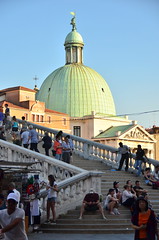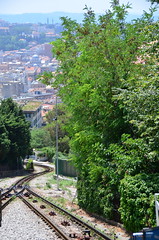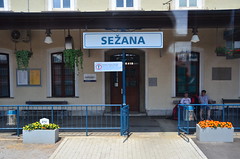The overland journey from Venice Italy to Slovenia’s charming capital city Ljubljana is not only beautiful, but also quick and easy: Two trains, an antique tram, a cross-border taxi ride, another train and you’re there!
Venice to Trieste

You’re likely to depart Venice from Santa Lucia station, near Ponte degli Scalzi bridge
The first step from traveling overland from Italy to Slovenia is getting from Venice to the city of Trieste, the closest major Italian city to the Slovenian border. Actually, it’s the second step. Allow me to explain.
The railway station that serves the “island” part of Venice, where you’re almost certainly staying, is Santa Lucia. Local “slow” trains operate direct to Trieste from Venice Santa Lucia, but with a travel time of nearly four hours, those didn’t interest me.
Instead, I took a local train the short 10 minutes from Santa Lucia to Mestre, the station serving “mainland” Venice, and hopped onboard a high-speed service to Trieste, which clocks in at just under two hours. The cost? Just €29 in first class, and €21 in coach.
Trieste to Villa Opacina

Take a tram out of Trieste and up the hill toward the Slovenian frontier
I made a beginner’s mistake upon arrival in Trieste: I asked an Italian person for directions to Piazza Oberdan, where the tram portion of our journey begins. I’m sure the pharmacist was well-meaning, but her directions got me lost and stressed out.
Getting to Piazza Oberdan, where you catch a tram to Villa Opicina near the Slovenian “border,” is in fact easy. Turn left out of the train station onto Via Miramare, turn slight left onto Via Carlo Ghega, then slight right onto Via Giosué Carducci.
The tram, which provides a sort-of panorama of Trieste as it rises hundreds of feet above the city toward the Slovenian frontier, takes 25 minutes to reach Villa Opicina. And the price? I have no idea; I intended to buy a ticket, but was never charged for one!
Crossing the Italy-Slovenia Border

Cross the border to Sezana and take the train to Ljubljana
The title of this section is a misnomer: Italy and Slovenia are both E.U. member nations, so the border station between the two countries in unmanned. You won’t need to show your passport when you travel from Villa Opacino to the Slovenian town of Sezana.
You will, however, need to taxi a taxi, unless you want to walk 4 km that is. I was lucky enough to find a taxi waiting near Villa Opacina station in Trieste, although railway travel guru “The Man in Seat 61″ says this is usually not the case.
As a precaution, he suggests you should email a request to pre-book your taxi although I did this and never received a response. My advice? Walk around until you find a taxi. Regardless of how you get your taxi to Sezana, it should cost you around €13.
Sezana to Ljubljana

That’s it! Welcome to charming Ljubljana!
By the time you board your train at Sezana station, the “hard” part of your overland journey from Italy to Slovenia is over — wasn’t so hard, was it? Buy the €7,27 train ticket, board any Ljubljana-bound train, then sit back, relax and enjoy the amazing scenery.
The journey from Sezana to Ljubljana takes just short of two hours, or around the same distance you traveled from Venice to Trieste. What’s fascinating is just how much the landscape changes over this short distance which, to be fair, spans over half of Slovenia.
To sum it all up, you take a train from Venice Mestre to Trieste (€29), a tram from Trieste to Villa Opacina, a taxi from Villa Opacina to Sezana (€13) and then a train from Sezana to Ljubljana (€7). €50 and six hours later, you’re in Ljubljana, Slovenia!

Robert Schrader is a travel writer and photographer who’s been roaming the world independently since 2005, writing for publications such as “CNNGo” and “Shanghaiist” along the way. His blog, Leave Your Daily Hell, provides a mix of travel advice, destination guides and personal essays covering the more esoteric aspects of life as a traveler.








